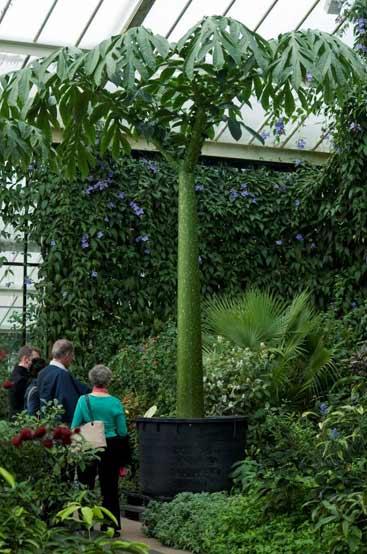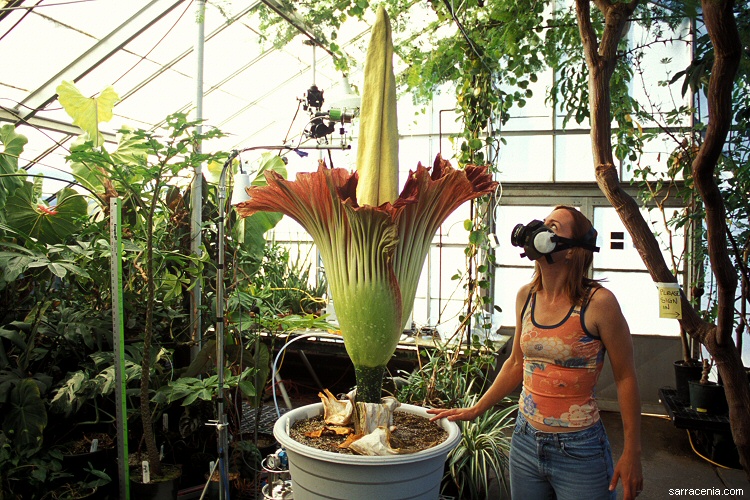Let’s talk about giants; giants who smell really, really bad.
I’m talking about the corpse plant of course. There are several species that go by this name (The plant kingdom is full of smelly characters), but I’m referring to Amorphophallus titanum, or sometimes, Titan arum. The name comes from ancient Greek, “amorphos” meaning misshapen, “phallos” meaning penis, and “titan” which means big. Think – big, weirdly-shaped penis flower that smells like rotting flesh. Cool, right?
Amorphophallus titanum, or A. titanum, is endemic to the forests of Sumatra, but has relatives all over the globe. It belongs to the Araceae family, which includes a small relative that are more familiar for some, the English Lords-and-Ladies (Arum maculatu) that are common in hedgerows. Other close relatives are the Skunk Cabbage (Symplocarpus foetidus) and the Dead-Horse Arum (Helicodiceros muscivorus). Many of the plants in this family are extremely, uh, shall we say aromatic?, just like their massive cousin. (Grayum, 1990)
The corpse flower is a fascinating species with a two-part life cycle, consisting of a leaf stage, and an intermittent flowering stage. It can take up to a decade for A. titanum to flower for the first time, with often many years in between flowering. (Don’t miss this time lapse video of a Corpse Plant blooming at the Chicago Botanic Garden.) During years where it doesn’t flower, it forms a single massive leaf. This leaf is where the photosynthesis occurs, like most plants. However, A. titanum is different from many plants in the way that it saves any of that excess energy. The excess energy is collected in a large starchy tuber under the ground. During a flowering year, A. titanum grows exclusively from these energy reserves.
It’s not hard to see why this species has ‘titan’ in its name. The flowering body alone can reach 9ft in height, with the underground part of the plant, its tuber, weighing up to 91kg. This titanic size is also a feature of the non-flowering portion of its life cycle. Most of the time, A. titanum has what is quaintly called a “leaf”. Now when I say “leaf” you’re probably thinking something along the lines of a maple leaf, or maybe a holly leaf. But those pale in comparison to A. titanium which reaches the height of a small tree, complete with several branches. (Hejnowicz, 2005) That! That monstrosity down there. That is the single leaf. It can grow to be well over 17ft tall. (Royal Botanic Gardens, 1926)

Amorphophallus titanum (Image used with the permission of the Trustees of the Royal Botanic Gardens, Kew)
The pollination strategy for A. titanum is, like most aspects of this plant, rather unique. During a flowering year the male parts release their pollen, and the following day the female organs become receptive. This almost entirely prevents self-pollination assuring more genetic diversity throughout the species. They are pollinated by carrion-feeding insects, which is where it’s rotten smell comes in. The foul odor fools the bug into thinking it is about to find a nutritious meal, when in fact it is being tricked into helping this smelly giant reproduce. A. titanum is only sparsely distributed throughout the forest and the pollen must sometimes travel great distances to find to another plant. By using such a pungent odor, the plant can attract insects from far and wide, giving it a greater chance of being pollinated. Some research suggests that the large male part of the flower, called a spadix, traps insects and then release them the following day when the ovaries are receptive to pollination. The male spadix deflates and the insects must wriggle past pollen to escape. Then, covered in pollen, the insect travels to the next “rotting corpse”, or rather, another Corpse Plant. Once the seeds are pollinated, the massive inflorescense, or flowering body, wilts around the developing fruit, which protects it from the insects and the elements. By the time it has rotted away, the fruit becomes ripe and shiny red. These are highly visible, tasty treat for bird species, and they will carry the seeds throughout the forest and help to start the cycle all over again. (For some really beautiful images of the corpse plant’s fruit, take a peak at the photo gallery displayed on Arkive.org.)
The chemicals responsible for this iconic smell are dimethyldisulfide and dimethyltrisulfide. They are part of a group of chemicals called Volatile Organic Sulfur Compounds. These are the same chemicals that produce other iconic, odorous smells: feces, limburger cheese, rotting flesh, and even smell of bad breath. Dimethyldisulfide is actually responsible for a lot of smells that we consider unpleasant. (Higgins et al. 2006) Dimethyltrisulfide is also highly detectable to humans, noticeable at just 1 part per trillion. This very effective at drawing insects across long distances, as I’m sure you can imagine.

Dimethyltrisulfide

Dimethyldisulfide
Unfortunately the corpse plant has been listed as a vulnerable species by the IUCN. This is due almost entirely to the deforestation of Sumatra. These forests are also homes to other threatened species such as the Rhinoceros Hornbill (Buceros rhinoceros) that is the corpse plant’s biggest seed disperser, and the seed disperser for many other unique and unusual species. To learn more about the dangers that threaten the forests of Sumatra, be sure to check out the IUCN page.
Citations:
Grayum M. 1990. Evolution and Phylogeny of the Araceae. Annals of the Missouri Botanical Garden 77:628.
Hejnowicz Z. and Barthlott W. 2005. Structural and mechanical peculiarities of the petioles of giant leaves of Amorphophallus (Araceae). American Journal of Botany 92:391-403.
Higgins et al. 2006. Cycling of Volatile Organic Sulfur Compounds in Anaerobically Digested Biosolids and its Implications for Odors. Water Environment Research 78:243-252.
Kew, Royal Botanic Gardens. 1926. Amorphophallus Titanum. Bulletin of Miscellaneous Information (Royal Gardens, Kew) 1926:374.


